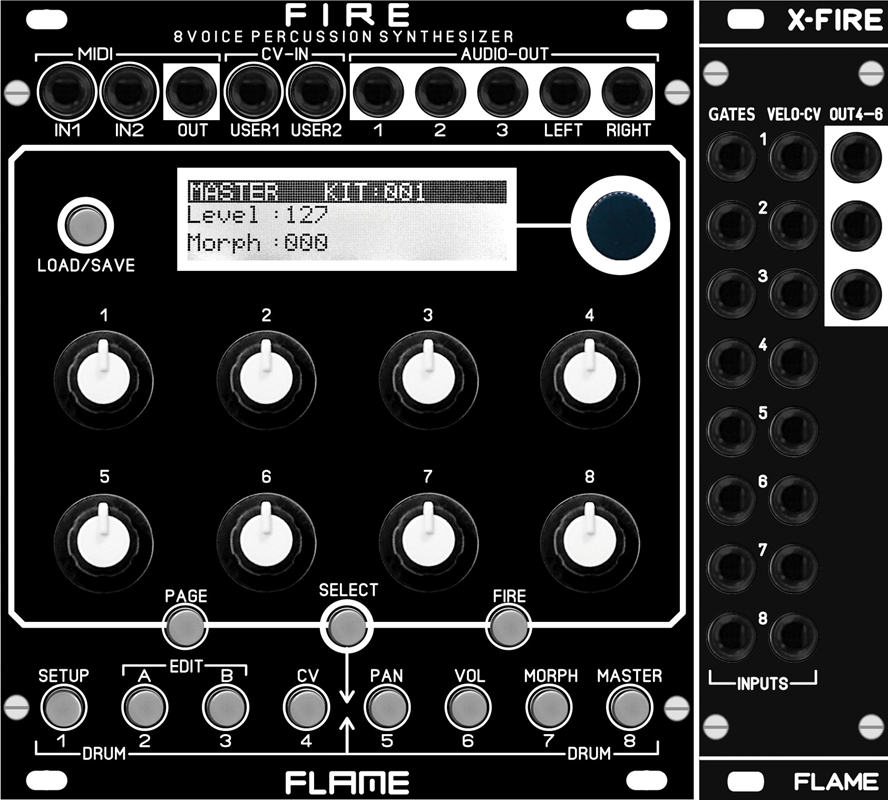September 2023 Eurorack round-up
This month’s best new modules include delay and interface modules from Intellijel, a powerful drum module from Flame, and a cheeky little acid voice from ADDAC.

Intellijel’s Sealegs is a stereo delay module, but as you’d expect from the Canadian Eurorack veterans, there’s more to it than that. The heart of the module is a multi-mode digital delay section, with the option to choose from Tape, Bucket Brigade, and Crossfading Digital models. There’s an overdrive circuit on the input, a pre- or post-delay reverb circuit, pre- or post-delay hiss and crackle, plus low-pass and high-pass filters. The three modes complement each other very nicely, offering distinct flavours of echo which lend themselves nicely to a range of different sounds. The dedicated Color control also introduces ‘tape-related degradations’, ‘BBD-related sonic anomalies’ or ‘digital-centric irregularities’ depending on the mode, accentuating and amplifying the character of each algorithm.
On top of the functionality itself, Intellijel have clearly put a lot of thought into how the Sealegs should work as both a hands-on effect and as part of a patch. There are no presets or menus, and there’s a dedicated control for almost every parameter. In terms of building patches with other modules, eight attenuverted modulation inputs offer extensive CV control of the key parameters. It’s a deeply engaging module which offers real breadth of sound, from laser-focussed tempo-synced digital clarity through to queasy, modulated grit. Full review coming soon.
The Stomp module is a more simple affair, but no less effective. Essentially an interface between Eurorack modules and guitar pedals, the Stomp allows you to process synth sounds through pedals and/or send guitar and bass signals into Eurorack for processing and back out to your pedalboard. There’s also a Class A triode emulator on the return input, allowing you to crank the gain and add valve-style overdrive to your signal. It’s a pretty straightforward idea, but it’s been executed very well here, especially in terms of how the worlds of synth modulation and effect pedal expression can work in harmony; the Stomp can convert CV signals to guitar expression input level, or generate expression using the built-in LFO. A sweetly effective module which opens up lots of options for guitarists and synth players alike.

Flame’s Fire is a rather austere looking eight-voice percussion module which proves more fun than its appearance might suggest. Each of its eight channels can be used for a range of virtual analogue of FM synthesis modes, with dedicated algorithms for snare, hi-hats, FM drum (which also works well for monophonic synth sounds), kick drum, bridged-T network (808 kick-style), rimshot, clap, tom, and UNI (‘universal’, for kicks, snares and synth sounds).
Sonically, the Fire lends itself particularly well to techno and electro, excelling at slightly edgy sounds and FM synth patches. There’s a lot of depth here, and while the display is fairly small and basic, it’s generally quite logical, with eight parameters displayed and edited using the main pots. Realistically, it’s best suited to those who are willing to put in a bit of time to learn their way around and experiment with the different algorithms to build custom drum sounds and kits.
A separate X-Fire expander module is included as standard, adding dedicated trigger and CV inputs for each of the eight channels, plus four more audio outputs in order to give you true individual outs (the main module has three assignable outputs plus a stereo pair for the mixed output).

Described as a voltage-controlled mixing console module, Xaoc’s Ostrawa 1966 is similar in design to the Praga 1967 mixer module, this time offering four stereo channels as opposed to the four mono inputs of the Praga. There’s CV control of balance and volume, but the real strength of the Ostrawa lies in its modularity; you can chain multiple modules together to increase the channel count, or chain them with Praga modules to create a custom Eurorack mixer.
The forthcoming Bohumin expander module gives you an additional stereo aux bus with voltage control, manual attenuators for both buses and gate inputs for automated clickless mutes (the Hrad module is a similar expander for the Praga). A versatile modular building block for your ideal mixing console.

ADDAC System ADDAC107 Acid Source
ADDAC’s 107 is a cheeky little synth voice with bags of character. ADDAC originally intended to design a complex analogue drum module, but decided that it worked better as a synth, which perhaps explains why the 107 deviates from the well-worn TB-303 formula which you might expect from an acid synth. Instead, it’s got its own personality, with a triangle/saw oscillator blended with a square wave, leading into a multi-mode resonant filter and a VCA designed to saturate and distort. You’ve got plenty of CV control, including the all-important accent input which helps define so many acid patterns. However, the more unusual option is the ‘excitation input’, which can accept a trigger, gate or CV input that gets amplified by the Input Gain control then processed with the AD envelope, effectively allowing you to sequence and modulate dynamics and saturation alongside the more conventional accent approach. Loads of character and great value at under £200.
Greg Scarth